Plan A Visit To State Historic Site: Bennett Place
Discover Bennett Place Historic Site, the location of the largest surrender of Confederate troops in the American Civil War Read More
Historic Stagville tells a story of Durham's beginnings and the enslaved people who's lives and work led to the city we know today.
Posted By Ronny Maye on Jun 03, 2024
If you want to know the history of Durham, you should start with a tour of Historic Stagville State Historic Site. On a recent visit, I had an opportunity to learn about the area and how they are preserving its history, which reignited a flame in me to explore the North Carolina narratives of yesteryear.
One of the things that North Carolina is known for is its agriculture and the production of crops. From livestock like chickens and hogs to Christmas trees, sweet potatoes and corn, agriculture is a multi-billion-dollar industry and a driving economic force in the Tarheel State.
Landowners have used their ripe soil to grow cash crops and amass wealth for centuries. Farmers have taken pride in tending their land alongside family in recent generations. However, before we can relish North Carolina's beauty and the abundance of family-owned farms, we must acknowledge its sordid past. Like other southern states, many North Carolinians grew cash crops like tobacco, cotton, corn and wheat using unpaid labor from enslaved Africans on plantations.
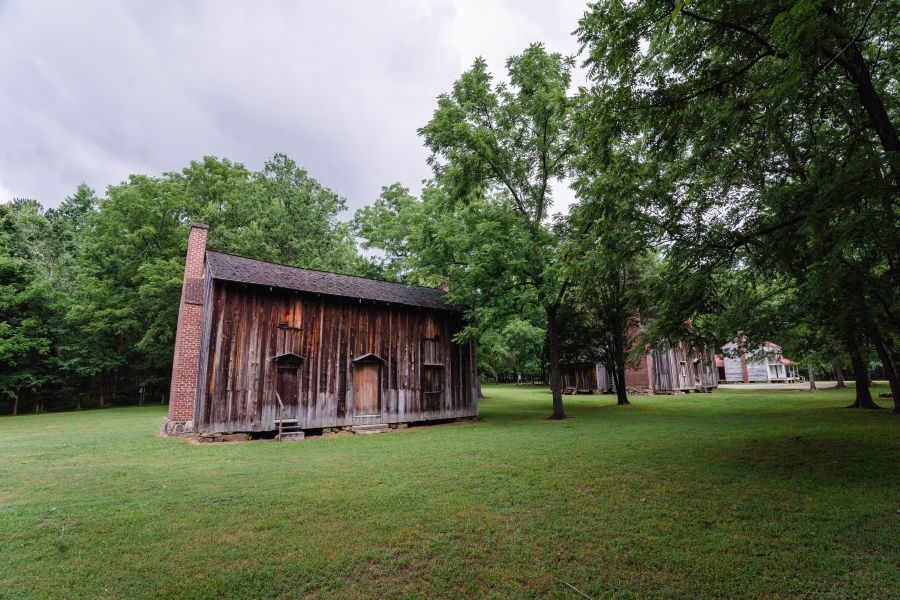
Stagville protects a number of original buildings from the plantation in their dedication to teaching about the lives and work of enslaved Africans and African-Americans. Photo: Discover Durham
The Transatlantic Slave Trade brutally transported Africans to places like the Americas, arriving at ports to be sold. Enslavers would place ads in the local newspaper or attend auctions to purchase people to perform free labor of housekeeping, farming, childcare or grueling skilled work. They would also sell, rent or trade enslaved people to settle their outstanding debts. Although slaves were often sold and bought for low prices, it quickly became a lucrative business. It was almost like a badge of honor for notables and elites to own human property.
One place where this occurred in North Carolina is the Historic Stagville Plantation, originally owned by The Bennehan and Cameron families. Spanning upwards of 30,000 acres and enslaving upwards of 1,000 people during its existence, Stagville was one of the state’s largest plantations from 1771 to 1865.
As a Black woman from the South, plantation tours are incredibly hard to do. Until recently, I stayed away from them. In my personal experience, tours tend to glaze over the reality of what transpired on plantations. The people enslaved on these lands were beaten, separated from their families, assaulted, starved and adapted to an egregious way of life for the benefit and financial gain of greedy individuals. While living history museums use artifacts, signage and interpreters to depict the realities, it does not begin to hold a match to what enslaved people endured.
Our tour began inside the visitor center reviewing the images of descendants on the gallery wall. According to the site manager, the photographs were contributed by family members or found among hundreds of documents and artifacts. In my previous plantation tours, enslaved people or their families have never been identified in this manner. I have only seen photos of the slave owners, their spouses and children. This added another dimension to the tour because it helped hone in on the atrocities.
As we moved to walking the grounds of Stagville, the experience can only be described as harrowing and surreal. We learned about the trail that ran through the property often used to transport goods purchased and I immediately envisioned scenes of worn and weary people being brought to their new homes. Flashes of the older enslaved people displayed in the gallery came to mind repeatedly. I thought about how my home was a place of peace, safety and refuge- something enslaved people were not afforded on this property.
Standing inside one of the slave quarters at Horton Grove gave us a realistic insight into how enslaved people lived, often crowded into a tiny space with makeshift furnishings and food scraps. In the bedroom, something that garnered my attention was the corn husk dolls, used by enslaved children. I took this tour with two of my nieces (ages 5 and 12), the youngest of whom may be a descendant of the Bennehan-Cameron family. I watched her run freely in the yard, blissfully unaware of her ancestors who were not given the same luxury. That full circle moment in and of itself, was an honor to witness.
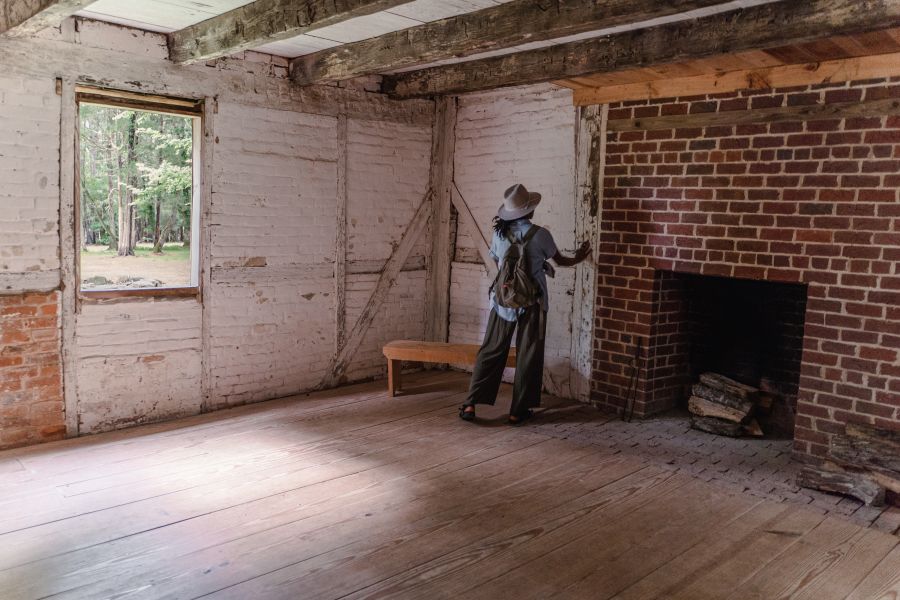
See the solemn story the walls at Horton Grove tell. Photo:
Present day, it is a state historic site. But initially, the land that went on to be Stagville Plantation was purchased from the Stag family by Virginian native Richard Bennehan in 1771. A successful businessman, Bennehan moved into the slave-trade industry, establishing his plantation by purchasing a 12-year-old child from Norfolk, Virginia. In a short five years, Bennehan purchased over 1,000 acres and enslaved two dozen men, women and children who grew cash crops of oats, cotton, tobacco and wheat.

The Bennehan house now houses the visitor center. Photo: Discover Durham
It was not uncommon for children of slave owners to inherit slaves. It was also common practice for children to be gifted slaves in times of celebration, including weddings. As such, Richard and Mary gifted their only daughter, Rebecca, 300 acres of land and 26 slaves when she wed Duncan Cameron in 1803. This gift marked the area of Stagville known as Farintosh Farm. For several generations, the Cameron family continued to purchase land and enslaved people, extending their footprint into other southern states.
Emancipation was a joyous yet trying time for many Africans and African Americans across the United States. They were grappling with the newness of freedom while finding a place to call their own after generations of enslavement. Some formerly enslaved individuals and families went to neighboring cities and states to start anew. They used their skills in brick masonry, farming, blacksmithing, carpentry and domestic tasks to survive. Simultaneously, we saw the onset of labor contracts, sharecropping and tenant farming as others remained on the plantations. Over half of the people (roughly 600-700) enslaved at Stagville continued to live there post-emancipation.
Conversations about what the day-to-day life on a plantation looks like often steer toward labor and brutality. While that is the gut-wrenching reality, day-to-day life on plantations should also reflect that enslaved men and women are still engaged in “regular” life activities. They found love amongst each other. They used traditions like jumping the broom to solidify their marriages, and they bore children. Despite horrifying conditions, they found moments of resilience and joy to create families and legacies of their own. For many, that familiarity and kinship added normalcy to their lives. Please note that this does not reference enslaved people who were raped or bore children with or married their slave owners.
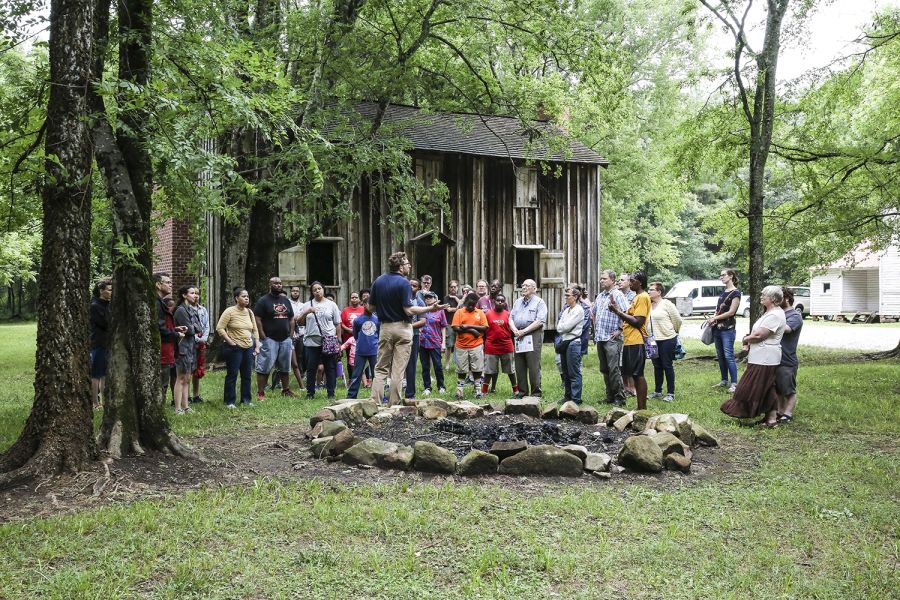
Guided tours are available, just call ahead to confirm. Photo: Keenan Hairston
As the plantation grew, it was divided into various complexes. One of which was the Horton Grove complex, an example of multigenerational slavery. Records have traced one family as being enslaved here for five generations. As the Camerons built more plantations in other states (and contributed to the NC railroad system), families were torn apart to do this work. As such, another reason for formerly enslaved people remaining on the plantations after emancipation (or staying relatively close) is the hope of reunification with family members who were sold or traded to other plantations or enslavers.
Some of those who fled Stagville settled in an area about 10 miles south in what eventually became the city of Durham. They were able to purchase land and homes. Early records of African American ownership in Durham show those owners were from the Stagville Plantation. Those families and their descendants become instrumental in establishing parts of one of North Carolina’s most beloved places to visit.
Stagville remained a site for Black sharecroppers until the 1940s. In the 1950s, the Cameron family sold it as farmland. However, in the 1970s, urban renewal projects dismantled nearly all the sites and buildings that once stood. What lines Old Oxford Road are several industrial complexes dedicated to tech or pharmaceutical companies. Remnants of the former 30,000-acre plantation have been preserved to share its history. Historic Stagville serves dual purposes in its dedication to honoring what transpired there. Primarily for visitors, it teaches about the life and labor of the enslaved people who lived and worked at the different complexes across Stagville Plantation.
Even with all the slave trades, sales and out-of-state labor, at any given time, hundreds of slaves remained on the Stagville Plantation. Over the years, thousands of descendants came from the men and women enslaved here. For this reason, Stagville also offers a genealogy research program (free of charge) to anyone who wants to trace their connection to Stagville or any of the Bennehan-Cameron plantations.
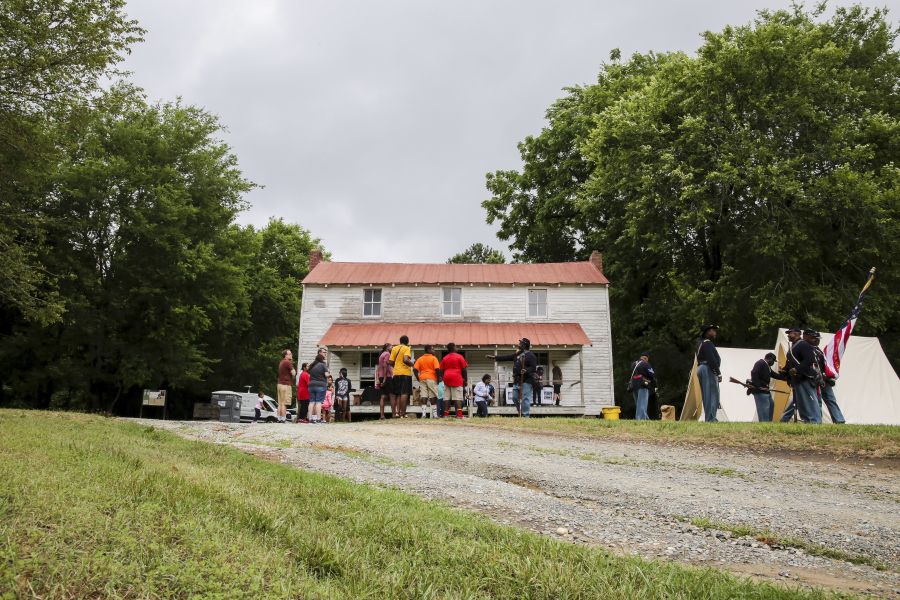
Historic Stagville sits on only a fraction of the land the original plantation covered. Photo: Discover Durham
Visitors can arrange a guided tour of the state's historic site or take a self-guided tour. Some of what remains on the property are the Bennehan family house and cemetery, the excavated foundation of an enslaved family's home and tobacco barns on the main complex. On the Horton Grove complex, four slave quarters are still standing, one of which is open for guests to walk through. In the visitor center, photos of descendants are displayed on a gallery wall.
Stagville has taken a step in the right direction to prevent this part of Durham, North Carolina, and American history from being erased. One hundred sixty acres remain to tell the story of nearly 1,000 men, women and children who forcibly called this place home. It tells the story of their enslaver's greed and quest to use forced labor to create generational wealth. When so many slave sites and plantations deduce the enslaved to a number or general reference, Stagville recalls them by name. In front of the Bennehan family home, we learned the story of Mary Walker, the only woman (and one of three people) who escaped Stagville. We were able to place our fingers into the engrained fingerprints of Daniel, a brick mason, and other enslaved people on the bricks of homes they built at the Horton Grove complex. It was there that we heard tales of Fannie and her reunification with her sons after being forced onto separate Cameron plantations.
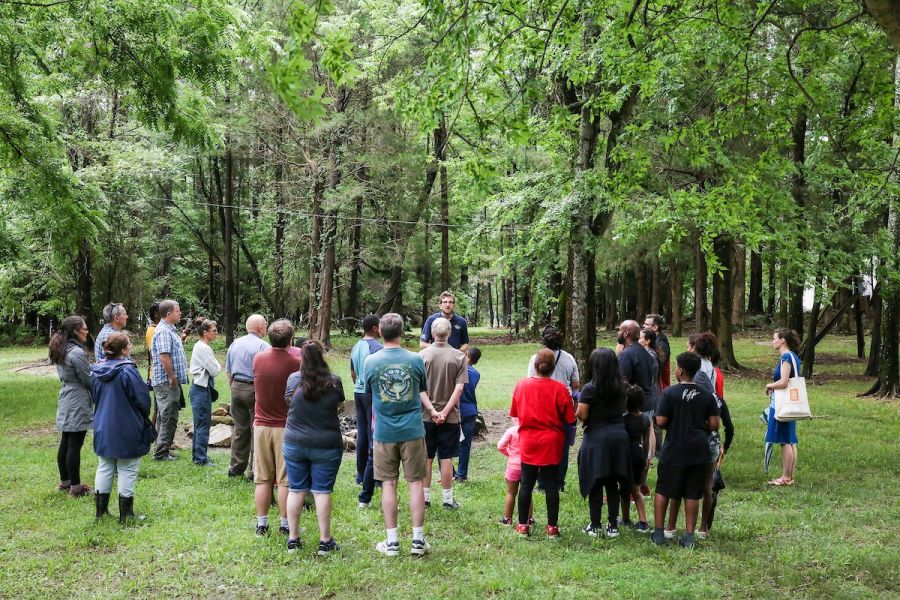
Almost a thousand African Americans were freed at Stagville at the end of the Civil War. Photo: Keenan Hairston / Discover Durham
There are more renovations and programming in the forthcoming years that will enhance the present-day experience. However, the education and guides thus far uniquely honor the lives born, lost and lived on the grounds of Stagville Plantation by centering them as human beings and not just slaves. It was an enriching experience that ignited a passion in me to learn more about the families from the Bennehan-Cameron complexes.
Location: 5828 Old Oxford Hwy.
Hours: Tuesday - Saturday, 9 a.m. - 5 p.m.
Guided Tours: Tuesday - Friday, 11 p.m. & 1 p.m.; Saturday, 11 a.m., 1 p.m., 3 p.m.
Accessibility: Historic Stagville is wheelchair accessible, with designated parking and pathways to accommodate visitors with mobility challenges.
Admission: Free, though donations are welcomed. Guided tours: $2; $1 for seniors or children ages 5-12.
Learn More: For more information, including special events, educational programs and group tours, visit the official Historic Stagville website or contact the site.
Plan A Visit To State Historic Site: Bennett Place
Discover Bennett Place Historic Site, the location of the largest surrender of Confederate troops in the American Civil War Read More
Plan A Visit To State Historic Site: Duke Homestead
From agriculture and infrastructure supported by the enslavement of Africans to The American Civil War, the city of Durham has an intricate... Read More